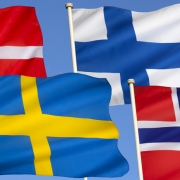Nearly half of millennials say they prefer socialism to capitalism, but what do they mean? “My policies most closely resemble what we see in the U.K., in Norway, in Finland, in Sweden,” Rep. Alexandria Ocasio-Cortez told “60 Minutes.” Yet Sweden’s experiment with socialist policies was disastrous, and its economic success in recent decades is a result of market-based reforms.
Until the mid-20th century, Sweden pursued highly competitive market-based policies. By 1970 Sweden achieved the world’s fourth-highest per capita income. Then increasingly radical Social Democratic governments raised taxes, spending and regulation much more than any other Western European country. Economic performance sputtered. By the early 1990s, Sweden’s per capita income ranking had dropped to 14th. Economic growth from 1970 to the early 1990s was roughly 1 percentage point lower than in Europe and 2 points lower than in the U.S.
Before its socialist experiment, Sweden had a smaller government sector than the U.S. By the early 1990s, government spending and transfer payments ballooned to 70% of gross domestic product, and debt had increased to 80% of GDP. Between 1966 and 1974, Sweden lost some 400,000 private jobs—proportionate to 16.7 million in today’s U.S.
In 1991 a market-oriented government came to power and undertook far-reaching reforms. Policy makers have privatized parts of the health-care system, introduced for-profit schools along with school vouchers, and reduced welfare benefits. Since 1997, government ministries that propose new spending plans have been required to find offsetting cuts in their budgets. As a result, public debt has declined from 80% of GDP in the early 1990s to 41%.
To increase incentives to work, Sweden reduced unemployment benefits and introduced an earned-income tax credit in 2007. The electricity and transportation industries were deregulated in the 1990s, and even the Swedish postal system was opened up to competition in 1993. The corporate tax rate was cut from its 2009 level of 28% to 22% today, and is scheduled to decline to 20.4% in 2021.
This policy mix has earned Sweden a Heritage Foundation ranking as the 15th freest economy in the world. The U.S. is 18th. And it’s paid off. Since 1995, Swedish economic growth has exceeded that of its European Union peers by about 1 point a year. Sweden is now richer than all of the major EU countries and is within 15% of U.S. per capita GDP. While Sweden still has a larger government than the U.S., its tax code is flatter. The progressivity of the U.S. tax code distorts incentives. These distortions would become even larger under the tax-increase proposals of democratic socialists like Ms. Ocasio-Cortez.
There is an example for the U.S. here, but the lesson isn’t what Ms. Ocasio-Cortez thinks. Command-and-control economic policies undermined Sweden’s prosperity, and they would do the same to America’s.
Mr. Fernández-Villaverde is a professor of economics at the University of Pennsylvania. Mr. Ohanian is a senior fellow at the Hoover Institution and professor of economics at UCLA.
This article appeared in the January 10, 2019, print edition of the Wall Street Journal.













